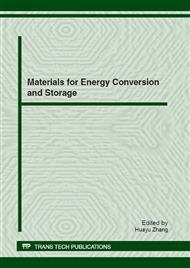p.96
p.100
p.104
p.108
p.113
p.118
p.124
p.128
p.132
The Preparation and Performance Study of Tin-Nickel Alloy Based Lithium Battery Anode Material
Abstract:
Based on copper foil, this paper takes electrodeposition to prepare tin-nickel alloy based anode material, which is of Sn 81.23% (Mass Fraction, the same as below), and Ni 18.77% (Mass Fraction, the same as below). It also studies the plating state, and plating structures and its electrochemical properties under heat treatment at different temperatures. The X-ray diffraction analysis (XRD) shows that the plating structures are all Ni3Sn4 and unalloyed individual-phase Sn under plating state and 200 oC heat treatment, and are Ni3Sn2 , Sn, Ni3Sn2 , Ni3Sn4 under 300 oC and 450 oC heat treatment respectively. In a button cell, which was made up with lithium slice, the results of charge-discharge cycle test and cyclic voltammetric curves test indicate that tin-nickel alloy’s specific capacity and charge-discharge cycle performance are related to the heat treatment temperature and structure of lithium battery anode material. The plating under plating state and 200oC heat treatment has high specific capacity, and its charge-discharge stability is well above that of the plating under other temperatures. Under 200 oC heat treatment, the plating could crystallize better and increase its content of Ni3Sn4. Its charge-discharge stability would be well above that of the original plating state. The scanning electron microscope (SEM) shows that before discharging, the plating of tin-nickel alloy was made up of small spherical particles, which are uniform and dense. The plating began to swell and crack after 50 times charge-discharge, which may lead to rapidly attenuate the plating’s specific charging capacity.
Info:
Periodical:
Pages:
113-117
Citation:
Online since:
July 2012
Authors:
Keywords:
Price:
Сopyright:
© 2012 Trans Tech Publications Ltd. All Rights Reserved
Share:
Citation:


